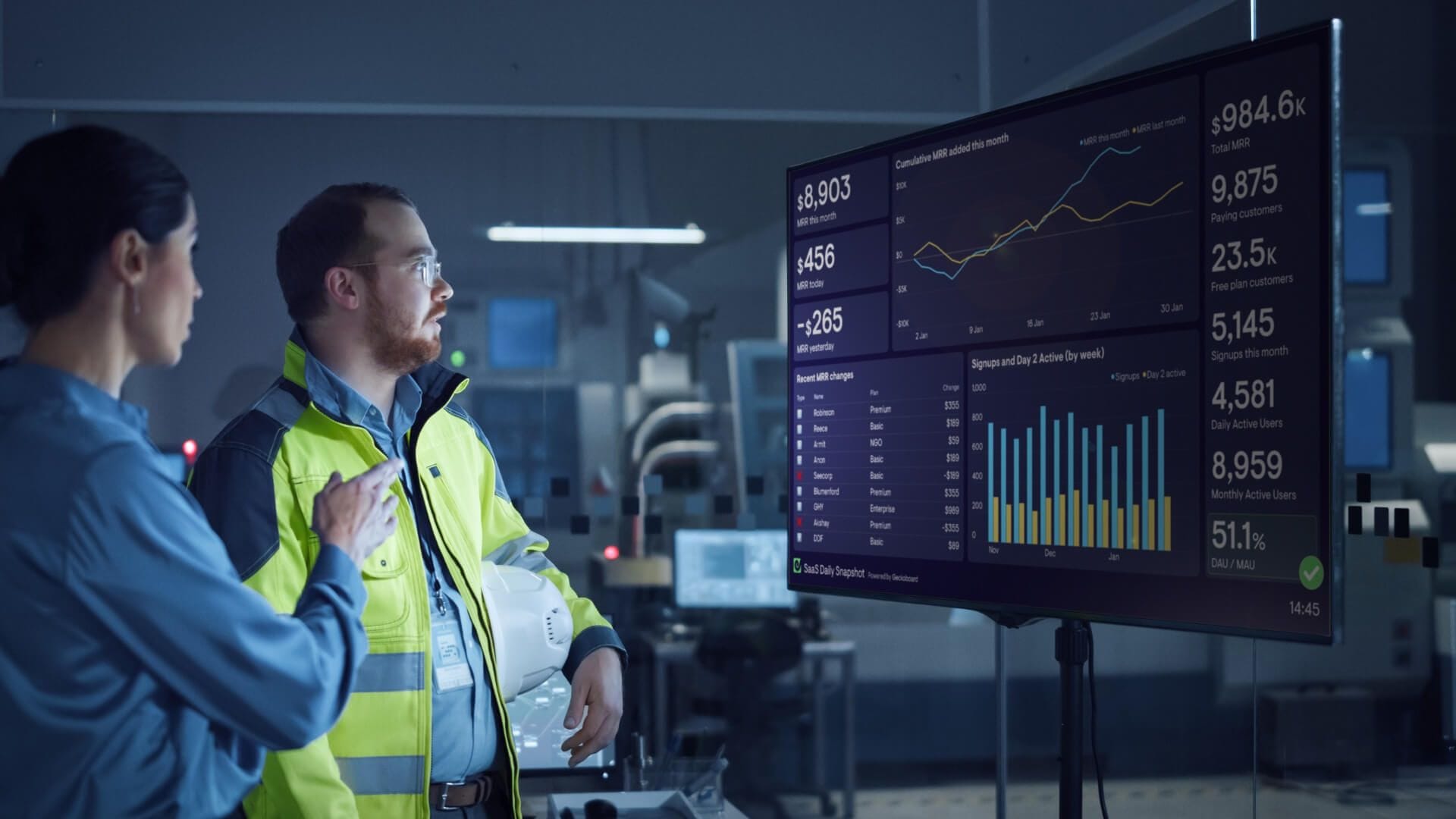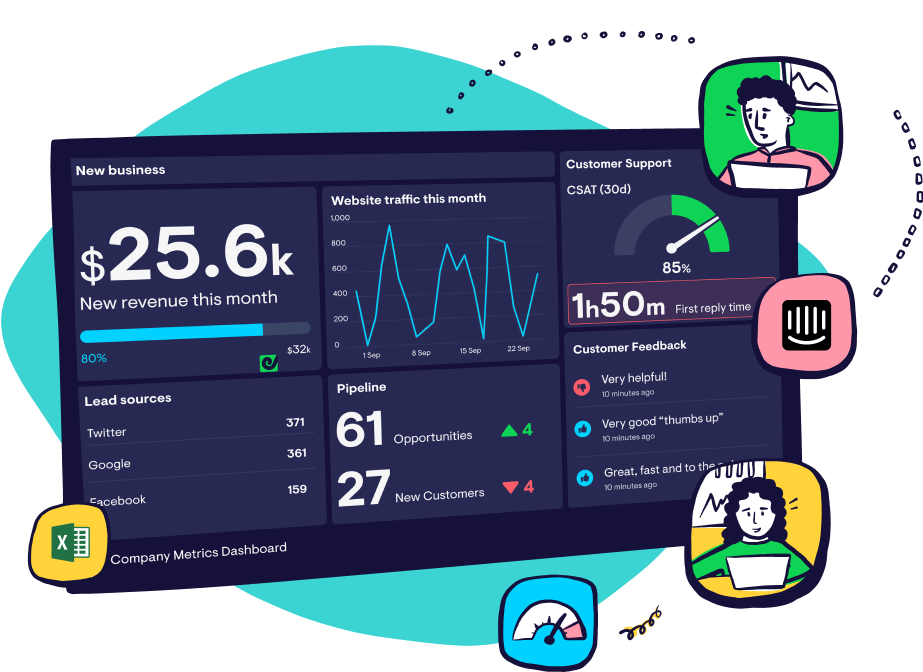Wallboard software plays a crucial role for organizations who want to communicate with people in physical spaces.
Wallboards allow businesses to display content dynamically on digital screens – these include corporate announcements, performance metrics and KPIs, news feeds and social media updates.
This guide aims to provide a comprehensive overview of wallboard software, including its features, benefits, and how to choose the right solution for your organization.
Introduction to Wallboard Software
Wallboard software enables the management and display of digital content across multiple screens, often used in public spaces, corporate environments, and retail settings. It's a powerful tool for engaging audiences, conveying information, and enhancing the aesthetic appeal of a space.
There are two main types of wallboard software, which have different use cases:
- KPI dashboards
- Digital Signage
Wallboard option 1: KPI dashboards
KPI dashboards display your company’s (or team’s) most important metrics, and are organized in a way that can be understood easily, at a glance.
When these dashboards are displayed on a TV in an office, they are sometimes referred to as wallboards. There are many reasons why a company might want to display metrics prominently in a shared space:
- Real-time monitoring: if you need to monitor your KPIs throughout the day, then a wallboard is perhaps the easiest, most efficient way of doing this. You simply need to glance up at your dashboard to see what’s changed and why. These types of dashboards are popular in contact centers, where customer service teams need to monitor service levels and the number of calls they are receiving.
- Team Alignment: displaying your KPIs helps your team to become familiar with the metrics that matter. Seeing these metrics every day contributes to a data-driven culture.
- Motivation: wallboards, particularly sales wallboards which show sales targets and leaderboards, are used to create a sense of accountability and motivation.
Choosing the right wallboard software for use as a KPI dashboard
To use KPI dashboard tool as wallboard software, you need to make sure it:
- Connects to the data sources you need to visualize, and updates in real-time.
- Is configured for TV display – meaning it looks good on a TV screen and is easily readable - even at a distance.
- Can be managed remotely, so you can change your dashboard without needing to disconnect the wallboard.
Recommended wallboard software for use as a KPI dashboard: Geckoboard
Geckoboard is perhaps the most popular dashboard tool on the market when it comes to setting up a KPI dashboard that can be displayed on a TV screen in the office, warehouse or any other shared space.
It connects to over 90 data sources, including Salesforce, Zendesk and Google Analytics, and you can design a dashboard in just a few minutes.
It’s perfectly optimized for TV display, and its Send to TV feature makes it easy to manage your dashboard (and loops of dashboards) remotely.
Read: Guide to setting up a TV dashboard
Wallboard option 2: Digital Signage
Digital Signage software on the other hand can be used to display a variety of visual media in shared spaces. Digital Signage software features include:
- Content Management: Allows users to upload, schedule, and manage various content types, including videos, images, text, and web pages.
- Scheduling: Enables content to be scheduled for display at specific times, making it ideal for targeting particular audiences or messages at different times of the day or week.
- Real-time Updates: Supports live content streaming, such as news feeds, weather updates, and social media posts, ensuring the displayed information is always current.
- Interactivity: Some wallboard solutions offer interactive features, allowing users to interact with the content through touchscreens or mobile devices.
- Remote Management: Provides the ability to control and update content across multiple screens from a central location, simplifying the management of large digital signage networks.
Benefits of Digital Signage solutions
There are many benefits to digital signage software:
- Enhanced Communication: Facilitates effective and dynamic communication with employees, customers, and visitors.
- Increased Engagement: Captures attention and engages audiences with visually appealing and interactive content.
- Operational Efficiency: Reduces the need for printed materials and allows for quick and easy updates to displayed information.
- Customization: Offers a high degree of customization to ensure the content aligns with brand identity and communication goals.
- Scalability: Can be easily scaled to accommodate an increasing number of screens or locations as the business grows.
Choosing the right Digital Signage software
When selecting wallboard software for your organization, you should consider the following factors:
- Ease of Use: Look for software with an intuitive interface that can be easily managed by your team.
- Compatibility: Ensure the software is compatible with your existing hardware and operating systems.
- Features: Match the software features with your specific needs, such as interactivity, remote management, and analytics capabilities.
- Scalability: Choose a solution that can grow with your organization, supporting an increasing number of screens and content complexity.
- Support and Reliability: Opt for providers that offer robust customer support and a proven track record of reliability and uptime.
Recommended digital signage software: Screencloud
Screencloud is a highly popular digital signage solution, and used by over 10,000 businesses worldwide. It integrates with over 100 apps, so you can display everything from the weather, to your latest company video.
What if I need both a KPI dashboard and digital signage?
Fortunately, if you need your wallboard to display both visual media and a KPI dashboard on a loop, then this is possible. However, you will need to use both a KPI dashboard tool and digital signage software – and also make sure that your digital signage software supports an integration with your dashboard tool.
For example, Screencloud supports a Geckoboard integration, meaning you can use Screencloud to cycle between your Geckoboard dashboard, and other visual media.

